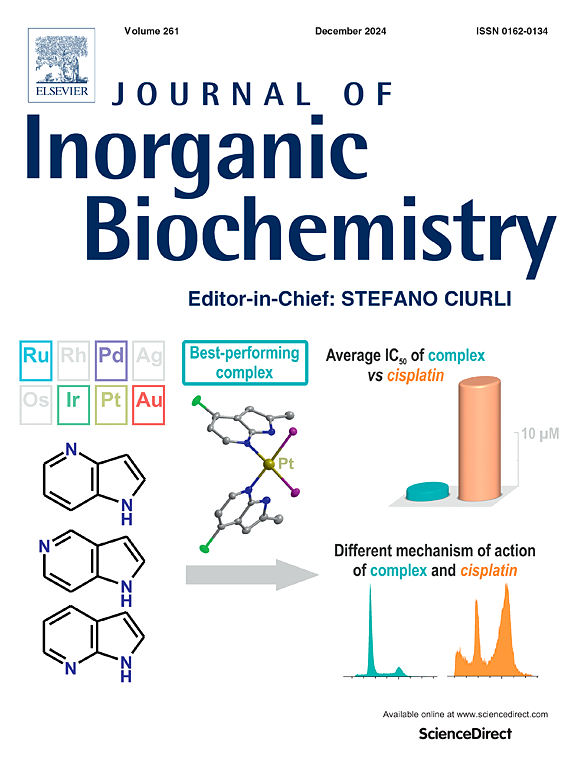Structure-function relationship within helical peptoids for Cu2+ chelation in the context of Alzheimer's disease
IF 3.2
2区 化学
Q2 BIOCHEMISTRY & MOLECULAR BIOLOGY
引用次数: 0
Abstract
Peptoids (N-substituted glycine oligomers) represent an excellent platform for drug development, such as selective chelators for Cu2+ ions towards chelation therapy, due to their efficient synthesis, high stability and good bioavailability. We previously showed that peptoids helicity is essential for selective Cu2+ binding and identified a unique peptoid hexamer, having 2,2′:6′,2″-terpyridine, and 8-hydroxyquinoline as metal-binding sidechains facing the same side of the helix, which exhibits high selectivity to Cu2+ ions. However, maintaining a stable helix required the incorporation of bulky chiral sidechains, resulting in a hydrophobic peptoid, insoluble in aqueous solutions, and limited in its use as a drug candidate. Our attempts to solubilize this peptoid led to the discovery of a water-soluble sequence able to selectively extract Cu2+ from Cu-amyloid complex, and by this stop the formation of reactive oxygen species (ROS) in the context of Alzheimer's disease (AD). This peptoid, however, had limited solubility in buffer solutions (that mimic biological environment), thus its potential for further development as a therapeutic for AD was limited. In this current study, we explore the structure-function relationship within a newly synthesized set of helical and water-soluble peptoids. By extensive spectroscopic analysis we test the effect of helix stability as well as the type and number of the solubilizing group(s) and their position along the sequence, on the solubility of these peptoids in buffer, and on their selectivity for Cu and ability to inhibit ROS production. The results provide insights about the relationships between the structure of the peptoids/Cu-peptoids and ROS production inhibition.

阿尔茨海默病中Cu2+螯合螺旋肽的结构-功能关系
肽类(n -取代甘氨酸寡聚物)由于其高效合成、高稳定性和良好的生物利用度,成为Cu2+离子螯合治疗的选择性螯合剂等药物开发的良好平台。我们之前的研究表明,类肽的螺旋度对选择性Cu2+结合至关重要,并鉴定了一种独特的类肽六聚体,具有2,2 ':6 ',2″-三吡啶和8-羟基喹啉作为金属结合侧链,面向螺旋的同侧,对Cu2+离子具有高选择性。然而,维持稳定的螺旋结构需要结合大量的手性侧链,导致疏水肽,不溶于水溶液,限制了其作为候选药物的使用。我们试图将这种肽溶解,从而发现了一种水溶性序列,能够选择性地从cu -淀粉样蛋白复合物中提取Cu2+,并通过这种方法阻止阿尔茨海默病(AD)中活性氧(ROS)的形成。然而,这种肽类在缓冲溶液(模拟生物环境)中的溶解度有限,因此其作为AD治疗药物的进一步发展潜力有限。在当前的研究中,我们探索了一组新合成的螺旋和水溶性肽的结构-功能关系。通过广泛的光谱分析,我们测试了螺旋稳定性以及增溶基团的类型和数量及其沿序列的位置对这些肽类在缓冲液中的溶解度的影响,以及它们对Cu的选择性和抑制ROS产生的能力。这些结果提供了关于类肽/ cu类肽结构与ROS产生抑制之间关系的见解。
本文章由计算机程序翻译,如有差异,请以英文原文为准。
求助全文
约1分钟内获得全文
求助全文
来源期刊

Journal of Inorganic Biochemistry
生物-生化与分子生物学
CiteScore
7.00
自引率
10.30%
发文量
336
审稿时长
41 days
期刊介绍:
The Journal of Inorganic Biochemistry is an established international forum for research in all aspects of Biological Inorganic Chemistry. Original papers of a high scientific level are published in the form of Articles (full length papers), Short Communications, Focused Reviews and Bioinorganic Methods. Topics include: the chemistry, structure and function of metalloenzymes; the interaction of inorganic ions and molecules with proteins and nucleic acids; the synthesis and properties of coordination complexes of biological interest including both structural and functional model systems; the function of metal- containing systems in the regulation of gene expression; the role of metals in medicine; the application of spectroscopic methods to determine the structure of metallobiomolecules; the preparation and characterization of metal-based biomaterials; and related systems. The emphasis of the Journal is on the structure and mechanism of action of metallobiomolecules.
 求助内容:
求助内容: 应助结果提醒方式:
应助结果提醒方式:


